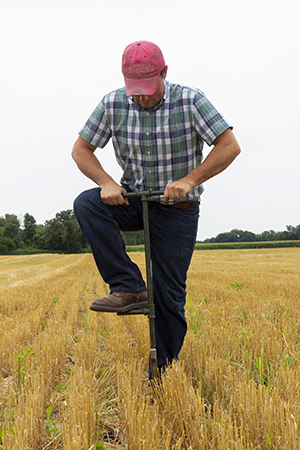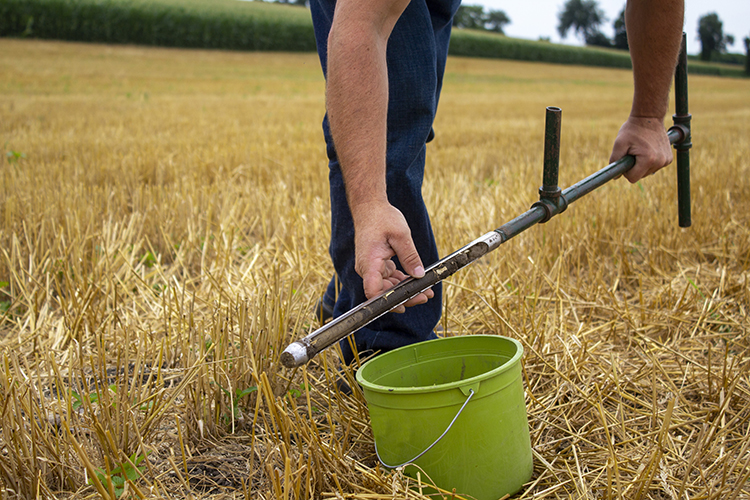This item has been supplied by a forage marketer and has not been edited, verified or endorsed by Hay & Forage Grower.
Spring soil sampling is right around the corner and the soil samples that will be pulled in 2021 will be providing useful data through the 2025 growing season. “Soil sampling is a major investment and carries tremendous value,” shares Scott Fleming, nutrient management specialist and sampling director for Rock River Laboratory.

“These samples will also drive most of the fertility management decisions on the farm.” Fleming explains that planning should be a key part of the process, long before a probe enters the ground. To help ensure representative samples are collected come spring or fall sampling season, Fleming recommends a few key questions to discuss with your agronomist:

What is the timeline?
Soil is always there. This means it can always be sampled. “While the first statement is true the second may require an asterisk,” quips Fleming. “The soil is always there, but pulling a high-quality soil sample isn’t always possible.”
Many factors come into play that prohibit pulling a quality soil sample. Frozen ground and snow can make collection impossible. Tillage can make getting through a field difficult and the fresh-tilled soil can make depth consistency a major problem. Thawing soil and excessive soil moisture can also make field access impossible.
Fleming recommends, “the best window to pull a soil sample is following harvest or after fields are fit for planting - up to 3-4 weeks after emergence.”
Is timeline important?
Sampling timeline can be a tricky subject. On one hand, there is a drive to pull samples in the fall and get results and recommendations back in time to apply fall fertilizer and perform fall tillage. On the other hand, fall can get short and wet, and keeping the plows moving is the goal. For this reason, many growers look towards spring sampling. After all, the soil is always there.
“The old adage was to never switch up the seasons when it comes to soil sampling,” says Fleming. If you normally sampled in fall, keep sampling in fall. If you sampled in spring, stay in spring. Why introduce another variable into interpreting the results? This strategy seemed ideal before mega data sets and far more samples in those data sets.
“At Rock River Laboratory we have conducted in-house comparisons of spring versus fall and found slight differences, but never enough to change a recommendation,” shares Fleming. “The two analytes that we’re most likely to see a change due to season are potassium and pH.”
He shares that in the study, the average change in potassium was about 3 ppm higher while pH was about .1 higher in the spring. The University of Wisconsin - Madison did a similar review of past data and found a similar trend. “While Dr. Carrie Laboski found this seasonal increase of soil test value to be slightly higher, the change was still not enough to warrant a major management change,” says Fleming.
Who will be pulling the samples?
With the role the sampling results will play for years to come, a qualified individual is an important cog in the sample collection process. Fleming also suggests if the grower has time to pull the samples themselves, it can serve as a valuable learning opportunity. “The grower knows what areas do well and what areas are frequent underperformers,” says Fleming. “The grower will also get a chance to see compaction and traffic management problems, sheet and rill erosion that would be missed from the cab, and disease and insect pressure that may have been missed at harvest.”
But a grower doesn’t always have the time or equipment to do their own sampling. If hiring out sampling, Fleming suggests asking the service provider who will be pulling the samples. “What is their background? What is their experience? These are all good questions to ask regarding the sampler,” suggests Fleming. “After all, results are only as good as the sample submitted to the laboratory.”

Where are my samples going?
When high-quality soil samples are pulled, they need to be submitted to a qualified laboratory.
“Be sure to ask where your samples are going,” recommends Fleming. “If you don’t ask, your samples may be submitted to a laboratory that is not approved in your state.” Different states have different requirements when it comes to soil testing. In Wisconsin, for example, a laboratory must be certified by the state and participate in the Wisconsin laboratory proficiency program. In other Midwestern states the requirements are different.
“The state may require participation in one of the nationwide proficiency programs such as Agricultural Laboratory Proficiency (ALP) or North American Proficiency Testing (NAPT),” explains Fleming. “At its core, a laboratory proficiency program requires labs to use specific prep and analysis procedures. It also requires the laboratory to analyze known and unknown check samples and submit them to the proficiency organization for validation.”
If you are unsure if your laboratory is certified for use in your state, Fleming recommends the first place to check is their website. Most laboratories have their certifications and proficiency program participation listed on their website. “Even if your state does not require soil testing laboratories to participate in a proficiency program, the customer should require it,” states Fleming.
With a bit of planning, the soil sampling process can provide even more value to the grower – for years to come. The best way to capitalize on this increased value is to make sure the best soil sample possible is being collected. “Review the sampling timeline to ensure it fits into your operational timeline,” shares Fleming. “When you decide it’s time to sample make sure the samples are pulled in a professional manner and sent to an accredited laboratory. After all, if you fail to plan, you are planning to fail.”
Founded in 1976, Rock River Laboratory is a family-owned laboratory network that provides production assistance to the agricultural industry through the use of advanced diagnostic systems, progressive techniques, and research-supported analyses. Employing a team of top specialists in their respective fields, Rock River Laboratory provides accurate, cost-effective, and timely analytical results to customers worldwide, while featuring unsurpassed customer service.

